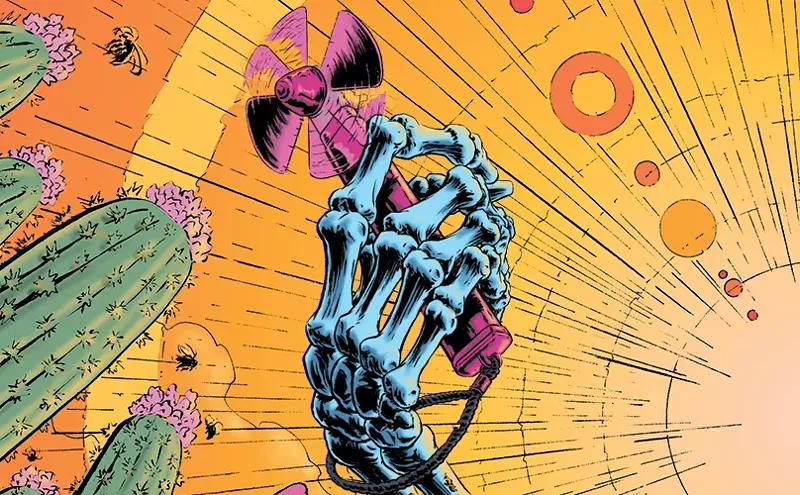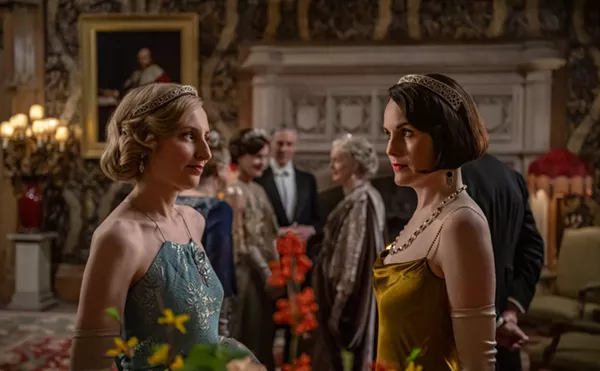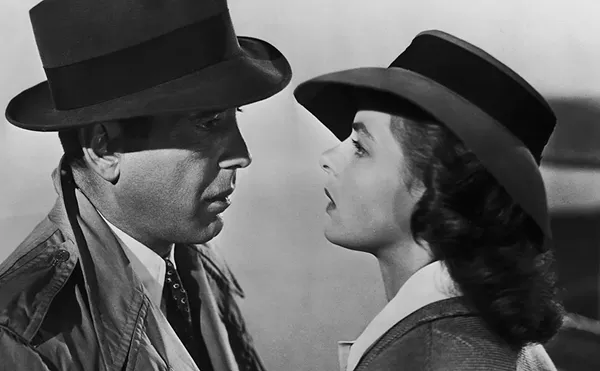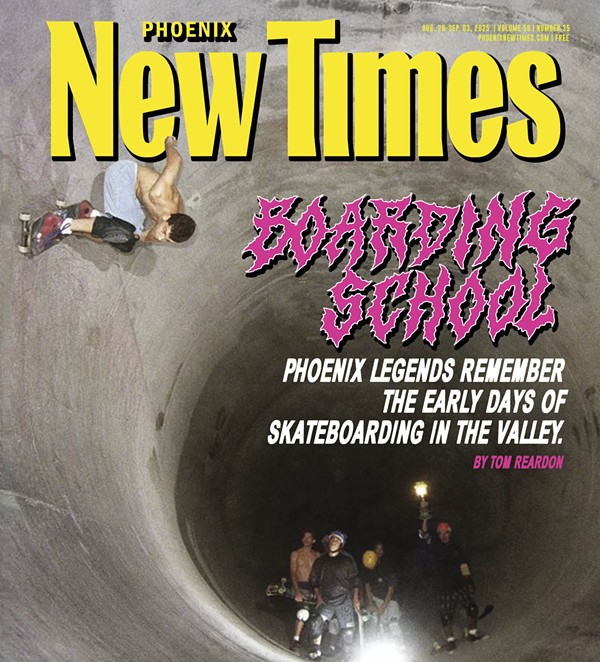It's the Fourth of July, and Jessica Nigri is alive with color. And just like the fireworks shows that are a hallmark of the holiday, the Phoenix resident has the rapt attention of a large audience.
It's an absolute mob scene inside the South Hall of the Los Angeles Convention Center during the third day of Anime Expo 2015, where tens of thousands of people have gathered. A couple of hundred of them are lined up around the booth for animation company Sentai Filmworks, waiting to see Nigri.
Clad in a vibrant costume of a pink halter top, a rainbow-colored skirt, and a fuschia wig topped by a multicolored halo, she's portraying the winged, angelic Jibril from the Japanese animation project No Game No Life. A day earlier, she made a similar appearance at Sentai's booth dressed as another anime character, Space Police Super Sonico.
Today, she's had a busy afternoon, including putting fans in headlocks for pictures, pretending to smoke cigars with Solid Snake, and giving out plenty of hugs. And there's still more than 100 people to interact with, including many in costume as various geeky and anime characters.
One of whom is L.A. resident Stephanie Sesay, who's dressed as Stephanie Dola from No Game No Life. And she's floating on cloud nine about meeting Nigri, an inspiration to her when it comes to wearing costumes.
As they pose for a photo, Nigri compliments Sesay's outfit.
"That looks really cool," Nigri says. "Good job with that."
The kudo couldn't have made Sesay happier.
"It made the environment a little more relaxing and inviting because she's very bubbly, very open, very friendly," Sesay says, "and that energy and excitement, you absorb it, and it feeds and inspires you."
Countless people from across the world are eager to meet Nigri, both online and at events like Anime Expo. Besides those waiting in the long line encircling the Sentai Filmworks booth, this corner of the hall is mobbed by onlookers eager for a glimpse of her.
A Sentai employee on the booth's public-address system reminds people that only those have tickets will meet Nigri: "If you don't have a ticket, go now. Apologies. I don't mean to break your heart."
The convention focuses on Japanese-produced animation (known as anime) and comic books (manga).
Nigri, 26, is a die-hard fan of anime, video games, and many other geeky subjects. She's also big into making and wearing costumes. All this is mashed up into cosplay, an artistic, do-it-yourself niche of costuming inspired by anything that geeks love passionately.
The term cosplay, like anime, originated in Japan and is a marriage of the words "costume" and "play."
There are thousands of other cosplayers in attendance at this year's Anime Expo, but none is as famous as Nigri, as evidenced by her enormous social media stats: 3.2 million Facebook friends, 1.1 million Instagram followers, and 469,000 Twitter followers.
She's popular because of her cosplay, but also because of her unique personality, super-friendly countenance, and love of all things nerdy. And it can't be discounted that she fills out a costume voluptuously.
Some cosplayers do it for the love. Others for the money. Nigri does it for both. She makes six figures annually by showing up in costume at dozens of conventions around the world and interacting with fans.
And she makes a lot of people in the nerd world angry. She's been called a sellout, a poseur, a charlatan, and a pariah.
She says she doesn't care anymore. And definitely not at the moment, as she continues to greet fans and pose for pictures with them at Anime Fest, as her boyfriend and fellow cosplayer, Ryan Brandt, stands nearby.
Nigri says what she does is "really awesome and really stressful, but it's really rewarding at the same time. It can be amazing or it can be terrible. I love it."
The loosest definition of cosplay is that it's the art and practice of putting together and wearing costumes inspired by the likes of sci-fi, gaming, anime, superheroes, fantasy, and comics.
There are builders (who spend months to years creating intricately detailed costumes), accuracy types (who value precise re-creations of whatever source), and purists (who believe cosplayers must make every aspect of their outfits).
Some cosplayers are more into mimicking armor seen in the first-person shooter games such as the Fallout series or the medieval kind seen in Game of Thrones. Others are into stomping around comic conventions as enormous robots of the Gundam or Transformers variety.
Not every participant goes hardcore, however, as there are those who'd rather wear sewn finery or dress head to toe in fur. Speaking of which, there also are gijinkas (who anthropomorphize animals into human-like beings) or those who lean toward funny, satirical costumes.
And then there's sexy cosplay — which Nigri does a lot of — where much skin tends to be shown.
Certain cosplayers stick with a particular niche while some straddle boundaries. Like "crossplayers," who specialize in portraying gender-swapped versions of characters. Combinations of different elements always are popular, like a zombified Imperial stormtrooper or the Victorian-era Joker and Harley Quinn seen at Phoenix Comicon.
Phoenix-area costuming couple Anabel Martinez and Allen Amis built a samurai version of Boba Fett that wowed millions online. They promote their work at various conventions.
"Some people build a cosplay that's a challenge, some want to see what they can invent through their closet," Martinez says.
Nigri has done it all, including commissioning entire costumes, accessorizing with other artists' props, or doing everything herself.
"It's like any other type of art," Martinez says. "Different styles appeal to different people.
"People can dig into their fandoms. Current, popular, those they grew up with, those they learned about through other people," she says. "There are the different genres, different mediums."
Cosplay also is about escapism, Nigri says.
"I think it's being able to step into someone else's shoes and become someone else and hopefully gain some of the attributes that character possesses . . . you might adopt these qualities and come out of your shell a little bit.
This is what happened with Nigri.
Jessica Nigri is in need of a new passport. Sitting on the patio of a Starbucks near her home in Ahwatukee, she flips through the stamp-filled pages of her current one while rattling off a dizzying travelogue of countries she's visited:
"There's New Zealand, Japan like six times, St. Maarten for a convention last year, Australia for a convention last year. It's been all over the place. Last year, I went to Nepal [and] hiked to the base of Mount Everest. That was just for fun, for my own sense of adventure."
The ink is barely dry on a few new passport stamps, as she and boyfriend Brandt just returned from a trip taking them from Calgary to Japan and then back to Canada for the Ottawa Comic Con. They're only in town for a couple days before they will jet to Washington, D.C., for a week before heading to the United Kingdom and the MCM London Comic Con. It wasn't their only visit to Europe this year, as the couple also went to Spain in late February/early March and visited Italy last month, where they clowned around in Rome and Venice for her YouTube videos.
"Vlogging" her adventures and daily life is what Nigri's concentrating on the most these days. As such, she's continually filming. "We vlogged the whole trip to Japan thing because I'm really focusing on my YouTube channel now."
So far, Nigri has visited five of the seven continents and has designs on someday traveling to Africa.
"That's definitely on the list," she says. "I'd love to go to South Africa and meet Yolandi and Ninja from Die Antwoord." If an AntarctiCon ever were to be held at the bottom of the world, Nigri would be there.
Brandt admits that the hectic nature of crossing continents with Nigri has been strenuous but worth it: "Jet lag is real. Going to London and then back to D.C. and then to Phoenix, it really kills you. It gets really tiring, but it's so much fun."
Nigri already was familiar with international travel from her youth, since her parents are from opposite ends of the world. One of three kids, Nigri was born in Reno, Nevada, in 1989. Her father is American and her mother is from New Zealand. The family moved to Christchurch, New Zealand, when she was a toddler and lived there until she was about to become a teenager.
Nigri, 26, is a die-hard fan of anime, video games, and many other geeky subjects. She’s also big into making and wearing costumes. All of this is mashed up into cosplay, an artistic, do-it-yourself niche of costuming.
tweet this
She grew up in the nerd culture, first encountering Pokémon at age 10. By then, she already had geeked around her father, Cory Nigri.
"My dad used to play Dungeons & Dragons with me when I was little," she says. "He bought all these figures from a garage sale . . . and he'd let me draw all the dungeons in chalk on the wood floors in the kitchen."
Cory also was into gaming of the console variety, when he wasn't working as a therapeutic specialty representative for pharmaceutical company GlaxoSmithKline, a job he held for 18 years. She remembers watching her dad battle zombies in Resident Evil or hide from soldiers in Metal Gear Solid. She says he was the nerdier than her mother, Jacqueline. Her mother worked at sewing and millinery, but she was an extra in Lord of the Rings: The Two Towers, playing a background character in the fort of Edoras.
"We were still in New Zealand when the movies were being filmed," Nigri says. "She was out there for two full days and got told by [director] Peter Jackson to stop staring at Ian McKellen. She was freaking about out, because, you know, it's Ian McKellen."
Nigri admits that while she dressed up for Halloween while growing up, like going out as the Cat in the Hat, she wasn't all that familiar with costuming as a teenager.
Nigri's introduction to cosplay came about almost by happenstance. She and her family had moved to Phoenix in the early 2000s. In 2009, she worked at a Trader Joe's after graduating from Desert Vista High School two years earlier, living in her parents' home and unsure of herself. Nigri attended that year's San Diego Comic-Con after a friend, local filmmaker Luke Malone, gave her a pass to the event.
It was her first convention experience and probably the most important. Though unfamiliar with cosplay, she decided to put some costumes together when a friend mentioned that people dressed up for the event.
"So I made a sexy Pikachu costume because I was like, 'Heh, that sounds fun,'" she says.
Inspired by the iconic creature from the animated television show Pokémon, it consisted of a canary yellow miniskirt, halter top, a high-waisted belt, pointed ears, and a tail. (She also wore a costume inspired by Rikku from Final Fantasy X at SDCC.)
Unsurprisingly, both Nigri and her Pikachu costume got noticed, including by a fellow convention goer who took her photo and uploaded it online. It went viral.
When Nigri got home, she had thousands of new friends on Facebook and MySpace. Turns out her SDCC badge, featuring her name and hometown, were visible in the photo, and people tracked her down.
Many blasted her for sexing up a beloved childhood favorite or because they said her efforts didn't contain artistic originality. Others were more supportive and praised her looks or the costume itself. Or went gaga over her endowments.
Nigri was a little spooked by the response and quickly took action.
"I hid my profiles and made a fan page and funneled everyone toward that, because I was worried about my family's being stalked over the Internet and harassed," she says.
But Nigri tried to focus on the positive. She had fun creating the costumes, wearing a couple at the convention, and interacting with the people there.
"I decided to stick with it, and a month later, I made other Pokémon costumes just for fun," she says. "Because that's what cosplay is supposed to be about, right? 'Play' is in the name for a reason."
More costumes followed, inspired by both Pokémon and anime in general. She started getting more into cosplay and developing her craftsmanship (including receiving sewing tips from her mother), setting up a personal website, and wading into greater Phoenix's cosplay scene.
In October 2009, she attended local anime-oriented Saboten Con while dressed as Yoko Littner from Japanese cartoon Gurren Lagann.
Her cosplay was well received, and this helped boost her confidence.
In 2011, she was named spokesmodel of the Amazing Arizona Comicon and appeared at a midnight release party for Gears of War 3 at the GameStop at Scottsdale Fashion Square.
Then, she scored a major coup the following year.
The late Forrest J. Ackerman, the legendary godfather of sci-fi fandom, is considered the earliest person to sport a costume at a convention.
In 1939, he was at the inaugural World Science Fiction Convention (a.k.a. WorldCon) in New York while speaking Esperanto and clad in a swashbuckling "futuristicostume," a sleeveless tunic, breeches, riding boots, and cape outfit influenced by pulp magazines and '30s sci-fi cinema.
WorldCon continued to be seminal to cosplay decades later, like when the first masquerade at a geek gathering was held at its 1940 event in Chicago.
In the 1970s and '80s, as anime surged in popularity in Japan, fans started showing up at events dressed as their favorite characters. In 1983, writer Nobuyuki Takahashi coined the term "cosplay" while covering such gatherings.
When anime and Japanese video games — not to mention Japanese culture, in general — started trending in the '90s in America, the term became popular here. Because of this, cosplay invariably has been linked to anime but extends to any sort of fandom.
And as the popularity of gaming, anime, and geek culture has exploded recently so, too, has cosplay's popularity.
Various forms of cosplay take place at every geek event these days, including at Phoenix Comicon, the largest stage for cosplay in Arizona. Like most Phoenix-area geeks, Nigri is a fan of the event and considers it to be her "home con." It's also the only Arizona event she attends anymore.
True to that spirit, Nigri went to this year's Comicon in May as an attendee instead of an official guest, spending time looking around in plainclothes in the exhibitors' hall, hanging out with friends like the Valley's Lindsay Elyse, who is becoming famous as a cosplayer, or doing a shoot dressed in costume with local photographer Martin Wong in the area surrounding the Phoenix Convention Center.
Phoenix Comicon director Matt Solberg says cosplay and costuming are wildly popular at the event — which peaked in 2014 at 77,818 attendees — rivaling comic books, genre authors, and science fiction.
"It's one of the most significant parts of Phoenix Comicon," Solberg says. "Visually, you can tell that cosplay is huge because so many dressed-up people are downtown."
Cosplay was given a specific area at this year's event, sharing the "Hall of Heroes," where local cosplay groups like the Arizona Avengers, devoted to Marvel Comics characters, and the Transformers-focused Arizona Autobots shared space with famed cosplayers, such as L.A.'s Ivy Doomkitty and local couple Aime and Lance Jaze.
Cosplay's growth also has meant an increase in money made by those involved. Just ask Nigri, who sells more than 50 images of herself in photo or poster form on her StoreEnvy site (jessicanigri.storenvy.com). In 2010, she became one of the first cosplayers to do this.
Allen Amis has experienced increased sales in recent years of the accurate-looking weapons, props, helmets, and armors he creates from such games as Fallout and Dragon Age.
"He [struggled] to sell bigger-ticket items his first few years at cons," says wife Anabel Martinez. "As the hobby grew, I think people realized the quality of the work, and [he was] making the right items at the right time."
Amis and Martinez aren't getting rich from the work, however: "[It's] not enough to quit his day job," she says. "But enough to save for new supplies, equipment, and car repair."
It's been different for Nigri. She won't say exactly how much money she makes per year, except to admit that it's well into six figures.
Her appearance schedule picked up after she won a contest on gaming website IGN via popular vote in 2012.
The prize was becoming the official spokesmodel for video-game developer Suda51's Lollipop Chainsaw, and getting to portray its ass-kicking, zombie-killing cheerleader heroine, Juliet Starling, in online commercials and at conventions. She also received $10,000 to make almost a dozen promotional appearances around the world, ranging from PAX East 2012 in Boston and gaming trade show E3 in L.A. to Tokyo's otaku-focused Akihabara district.
Whether it was because of her looks, cheeky personality, or that she's mobilized her fans, Nigri has become world famous.
Suda51 tapped her to depict Vivienne Squall from its hack-and-slash title Killer Is Dead at conventions while Ubisoft sent her to Germany to dress up as a crossplay version of Connor Kenway from Assassin's Creed IV: Black Flag. And she got to portray sexy scientist Miss Monday from Tecmo Koei's Yaiba: Ninja Gaiden Z at the Penny Arcade Expo.
This all happened in 2013, the same year that she voiced Cinder Fall in Rooster Teeth's anime-influenced online web series RWBY, appeared at a dozen conventions worldwide, and served as an interviewer for GameSpot's YouTube channel.
Much of Nigri's work with anime and video-game studios has come about because more companies are hiring cosplayers to portray their characters and promote their products at conventions, eschewing mainstream professional models.
"[Models] typically don't know what they're advertising," Nigri says. "A cosplayer is somebody who is usually so dedicated to the fandom of the project that they've created a costume for it."
Nigri says a typical appearance for an anime or game company at a convention involves hanging out at the booth each day, meeting and taking pictures with people, and talking to them about its products.
It's easy to do, Nigri says, since she's always geeked out about whatever projects she's involved with, especially Super Sonico, one of her favorite animes. When Sentai Filmworks approached her earlier this year to voice the titular character in the Americanized version of the series, Nigri's emotions got the better of her:
"They were like, 'Do you want to be Super Sonico?' and I was so excited that I cried."
If Jessica Nigri hasn't been up all night working on cosplay, she'll wake up at 6 a.m. and go for a six-mile run, followed by a few hours of crafting time, answering e-mails, doing interviews, making and posting YouTube videos, and gaming.
If it's before a con, however, Nigri might wind up working around the clock on costumes. Her family's had to adjust to her career and its needs, including making room for Jessica's costumes, something Jackie Nigri described in a 2014 interview with GeekPrideTV.
"We have no space in our house anymore," Jackie said, laughing.
Fellow cosplayer Ivy Doomkitty has been friends with Nigri since 2012 and says Nigri's "craftsmanship and level of detail [with her costuming and portrayals] have grown by leaps and bounds in the last year."
And despite Nigri's reputation, Jessica's work doesn't always involve cleavage, Doomkitty says.
"Are most of the costumes sexy? Yes, I'd be lying if I said they weren't," Doomkitty says. "[But] she's done Link from Zelda . . . and very little is revealed."
The time involved with creating cosplays varies with their complexity.
Simpler outfits, like those from Pokémon (including Lugiere, Espeon, Mew, and Houdoom) involving sewing, appliqué, or bedazzling faux jewels on cloth, take only a day or two. Far more complex armor-oriented costumes made by shaping, cutting, and gluing materials like ethylene-vinyl acetate foam (the same stuff found in children's play mats) or Worbla thermoplastic, require "three weeks to three months" to finish.
“Vlogging” her adventures is what Nigri is concentrating most on these days. She’s continually filming for her YouTube channel.
tweet this
And as much as she loves Pokémon, Nigri loves cosplaying female characters in armor just as much. This goes double if there's cleavage involved, like with the Death Knights from the online role-playing game World of Warcraft.
"It's the epitome of the female form, doused in armor, ready for battle, but still looking hot as fuck," she says.
Sometimes, Brandt assists her with creating costumes.
"He's my first boyfriend who's been a cosplayer," Nigri says. "It's cool because he understands the stress and the craziness of con life, and he can actually come with me and be a guest at conventions, as well, because he's very talented himself. We can just work off each other and help each other with projects."
Cosplay was one of many mutual interests they bonded over after meeting through a shared friend. They both love Pokémon.
"Pokémon was the first thing we talked about," he says. "Our personalities just clicked. We see eye-to-eye on all sorts of things, and we're both spazzes, unfortunately.
You can see the couple spazzing out together in many of the videos she's uploaded to her YouTube channel (www.youtube.com/user/jessicanigri), whether goofball discussions, chaotic high jinks, or bizarre dancing are involved.
Sometimes they're together on "Mail Monday," a regular YouTube installment where Nigri goes through all the letters and gifts she gets from fans, cracking wise about both and "just acting stupid."
It's through YouTube "vlogging" that Nigri's cheeky personality shines through. She seems to never take herself too seriously, is bizarrely captivating, remarkably profane, and sometimes utterly wrong. She cracks jokes, mugs for the camera, and acts the fool. And, yes, this often involves her breasts, either as subject matter, the punchline of a joke, or a prop. But nothing gets explicit, save for the profanity.
This is not true with many her fans, however, who clog the comments sections of her videos and Facebook posts with countless obscene remarks and lustful requests.
Heard any good cracks about Jessica Nigri? She says she's heard them all before.
Cosplay purists criticize her for not making her own costumes, which they claim are too simple, contain little artistic interpretation, or stray wildly from the source material. Then there's the allegation that she's dressing to accentuate her well-endowed female form to pander to horny male geeks and to promote herself.
Oh, and Nigri's in cosplay for money and fame. As such, she's a poseur who isn't into games, anime, or anything else nerdy. In essence, she's a "fake geek girl" attempting to infiltrate the scene.
Gamer Jake Khosrowzadeh encompassed many these criticisms in a 2014 post on the forums of gaming website Manly Game Days:
"Nigri is the kind of person who found a niche by pandering her body in . . . cheap costumes that only mildly resemble a beloved character, and receives unwarranted attention from a demographic that doesn't understand that her provocation doesn't make it actually interesting . . . Nigri feels that [being more original would] only get in the way of her chest."
And there are those who say she got implants to appear sexier and thereby nab the interest of male nerds.
When she denies all of it — and she has repeatedly — her detractors call her a liar.
Whatever she says, they claim she's taking attention and money away from more creative and deserving artists, plus setting a bad example for girls.
In essence, by oversexualizing cosplay, she's ruining it, they declare.
To the contrary, Ivy Doomkitty insists, Nigri's helping people discover cosplay, making it hugely more popular:
"She brings in fans, they want to meet her, they want to talk to her. And she's an absolutely amazing and friendly person."
Doomkitty chalks up the shade thrown her friend's way to jealousy over her success.
"Many people want her notoriety," she says. "Many people want to do all the things she's done."
Nigri feels it isn't necessary for cosplayers to go through a painstaking creation process regarding everything.
"I know there are a lot of people in the community [who're] like, 'It has to be perfect. It has to be amazing. You have to spend all this time, and you have to sew your own shirt, and you have to sew your own underwear and all this stuff,' and I'm like, 'Ugh, no, cosplay is supposed to be fun.'"
“Nigri is the kind of person who found a niche by pandering her body in . . . cheap costumes that only mildly resemble a beloved character,” gamer Jake Khosrowzadeh wrote.
tweet this
Nigri's sexy cosplay has caused drama at conventions.
For instance, at PAX East 2012, during her visit promoting Lollipop Chainsaw, she was asked to change her skimpy Juliet Starling costume of a body-hugging pink jumpsuit with the zipper lowered to the navel after it was deemed inappropriate because children were present. Nigri changed into Starling's main costume from the game, a skimpy cheerleading outfit. It, too, was considered to be too risqué, and (despite the fact she'd worn it at the event the day before) PAX East organizers prohibited it, too.
Cons worldwide, including Phoenix Comicon, have similar decency policies, but Nigri's hasn't been told to change an outfit since.
Nigri insists that her sexy cosplays don't objectify her or women in general.
"I know I dress sexy, and if people are going to catcall me," Nigri says, "I have the arsenal and ability to defend myself."
Nigri says her critics only empower her:
"It gave me dragon scales when I first started, it made me want to get better, it made me work harder, it made me want to live harder, to be happier. It made me kinder, more understanding and loving," Nigri states on Facebook.
"You are making it so I don't have to have a regular job anymore," she says to her detractors. "I could retire right now because your hate drove me to work hard and sell prints and do shows."
And she may retire in two or three more years, she says. She wants to use her experiences from geekdom and cosplay to possibly start a game company.
She says she doesn't want to stay in the spotlight too long.
"I don't want to be William Shatner," Nigri said in an interview with Constantly Calibrating at Phoenix Comicon 2015.
It's the last hour of Nigri's Anime Expo appearance on July 4, and Sentai's staff is trying to keep the line moving so they can wrap up her appearance. There's a small pile of presents and cards over to one side of the booth near boyfriend Brandt that have been dropped off for her birthday the following month.
At one point a group of bare-chested muscular male cosplayers in boxer briefs and Dugtrio masks start frantically dancing and gyrating just outside the booth.
It catches Nigri's eye, probably because of her love of Pokémon, and she beckons them over to dance around her to the bouncy house music soundtrack booming over the P.A.
"Yeah, come in here," she says, smiling mischievously. They obey immediately.
"Are you sure about this?" one asks.
"Yeah, yeah," Nigri says. "Could you just do that dance around me?"
There's confusion among the Sentai employees over the sudden invasion.
"Jessica does what Jessica wants," the emcee quips. "We got no control."
True, Nigri's in charge of her own life. Always.











